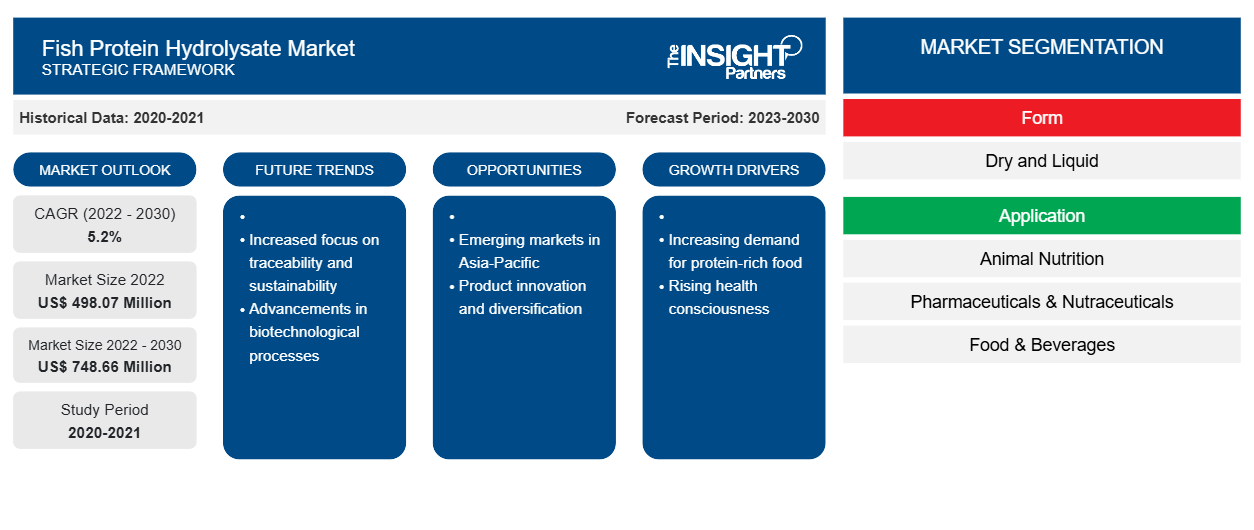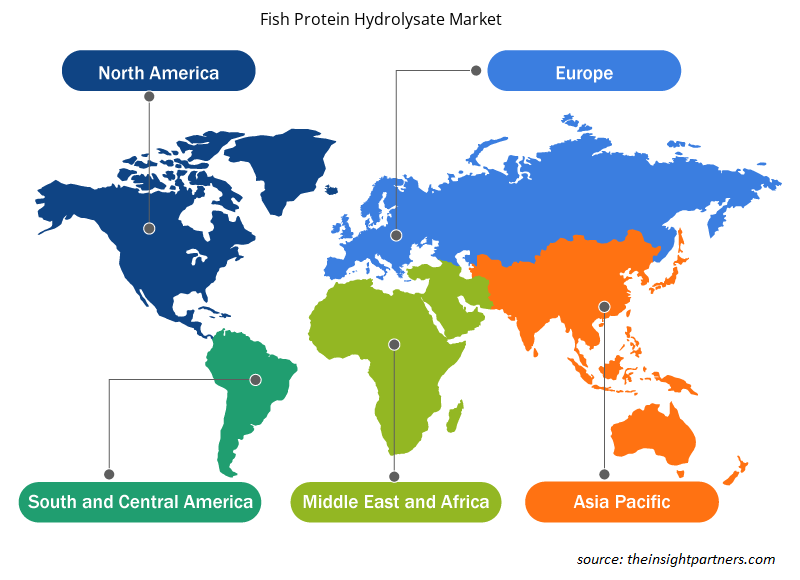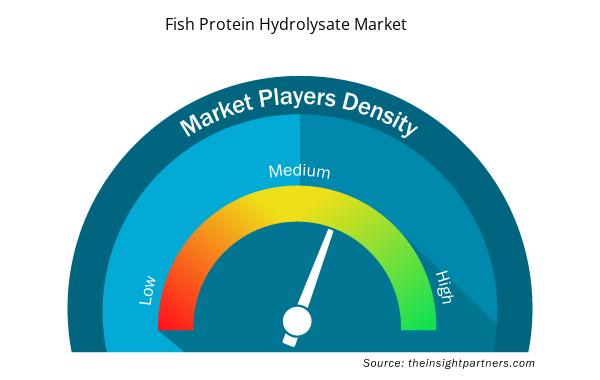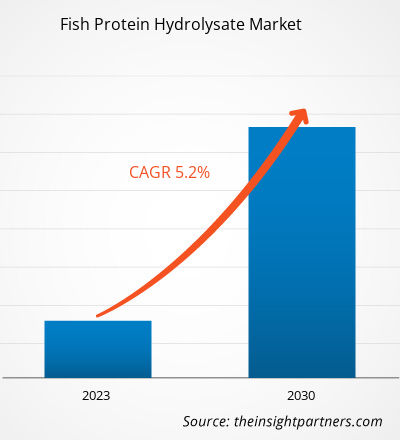[Research Report] The fish protein hydrolysate market size is expected to grow from US$ 498.07 million in 2022 to US$ 748.66 million by 2030; it is estimated to register a CAGR of 5.2% from 2022 to 2030.
Market Insights and Analyst View:
Fish protein hydrolysate is a product made from fish or fish material by the method of protein hydrolyzation. Thus, fish protein hydrolysate is a mixture of broken proteins. Fish protein hydrolysates are reported to have a number of improved properties compared to the protein of origin, namely improved functional properties and bioactive properties such as anti-oxidative or anti-hypertensive activities. Recently, fish protein hydrolysate is also started to be used as cryoprotectants for frozen fish products. These are the factors expected to drive the fish protein hydrolysate market growth during the forecast period.
Growth Drivers and Challenges:
There is a rapid growth in the production of fisheries and aquaculture industry driven by the development of fishing technologies. With rising production of fisheries across the globe, fish waste is produced in a substantial amount. According to The National Institute of Biotechnology Information (NCBI), about two-thirds of the total fish production is discarded as waste. Fish waste can be converted into value-added products such as FPH by adding various proteolytic enzymes. The skin, heads, bones, viscera, and liver of fish waste is a good source of amino acids, antioxidants, proteins, and peptides. The waste has also been found to possess desirable bioactive and functional peptides. Thus, companies are highly emphasizing on using fish waste as protein for various industries including food & beverages, animal feed, and nutraceuticals. Thus, increasing fish waste by aquaculture and fisheries further drives the fish protein hydrolysate market growth.
Moreover, FPH is a good source of protein and nutrients such as phosphorus, calcium, and other minerals. It helps prevent the spread of infectious diseases and boosts animal immunity against fungi, bacteria, viruses, and parasites. Regular consumption of FPH by broiler chickens helps in their muscle development. FPHs can enhance animals' metabolic systems, which protects them from the risk of diseases and infections. Thus, the nutritional benefits of fish protein hydrolysate relating to animal health drive its demand among animal feed industries.
However, a lack of a well-organized collection, storage, and transportation model creates further hurdles, whereby fish by-products may get wasted. Also, unforeseeable roadblocks prevent the smooth movement of fresh food supply chains, resulting in the wastage and restraining market demand.
Customize This Report To Suit Your Requirement
You will get customization on any report - free of charge - including parts of this report, or country-level analysis, Excel Data pack, as well as avail great offers and discounts for start-ups & universities
Fish Protein Hydrolysate Market: Strategic Insights

- Get Top Key Market Trends of this report.This FREE sample will include data analysis, ranging from market trends to estimates and forecasts.
Customize This Report To Suit Your Requirement
You will get customization on any report - free of charge - including parts of this report, or country-level analysis, Excel Data pack, as well as avail great offers and discounts for start-ups & universities
Fish Protein Hydrolysate Market: Strategic Insights

- Get Top Key Market Trends of this report.This FREE sample will include data analysis, ranging from market trends to estimates and forecasts.
Report Segmentation and Scope:
The global fish protein hydrolysate market is segmented on the basis of form, application, and geography. Based on form, the market is bifurcated into dry and liquid. Based on application, the market is segmented into animal nutrition, food & beverages, pharmaceuticals & nutraceuticals, personal care, and agriculture. Further, the animal nutrition segment is subdivided into poultry, ruminants, swine, aquaculture, pets, and others. The fish protein hydrolysate market, based on geography, is segmented into North America (the US, Canada, and Mexico), Europe (Germany, France, Italy, the UK, Russia, and the Rest of Europe), Asia Pacific (Australia, China, Japan, India, South Korea, and the Rest of Asia Pacific), the Middle East & Africa (South Africa, Saudi Arabia, the UAE, and the Rest of Middle East & Africa), and South & Central America (Brazil, Argentina, and the Rest of South & Central America).
Segmental Analysis:
Based on form, the fish protein hydrolysate market is segmented into dry and liquid. The dry segment holds a larger share in the market. The demand for fish protein hydrolysate in power form is higher than liquid form owing to a longer shelf-life and ease of transportation and storage. These factors drive the market growth for the powder segment.
Regional Analysis:
Geographically, the fish protein hydrolysate market is segmented into five key regions—North America (NA), Europe (EU), Asia Pacific (APAC), South & Central America, and the Middle East & Africa. Asia Pacific dominated the global fish protein hydrolysate market; the market in this region was valued at US$ 170 million in 2022. The market in Europe is expected to register a CAGR of 4.8% during the forecast period. Developed and developing countries in Asia Pacific witness growth in urbanization, coupled with the rising middle-class population, offering several opportunities for the market players. Factors such as increased demand for protein supplements coupled with increased use of the personal and sports fitness product drive its demand in APAC.
North America accounts for the second-largest share of the fish protein hydrolysate market, accounting for nearly ~30% market share. The US and Canadian consumers are moving toward a healthy lifestyle, and they prefer products that provide health benefits. The increasing health concerns among consumers thus drives the growth of the North American market for fish protein products. Health benefits from both animal and plant food sources help boost energy levels, strengthen muscle and bone structure, and increase focus and concentration among a variety of other health benefits, thus this region is inclined toward the aqua nutrition. Due to this factor, the demand for fish protein hydrolysate is rising in North America.
Industry Developments and Future Opportunities:
Initiatives taken by key players operating in the fish protein hydrolysate market are listed below:
- In May 2021, Biomega Group, which is a leading bioscience company producing marine ingredients, announced the expansion of its biorefining footprint by investing in a new greenfield site in Hirtshals, Denmark. The purpose of investment was to expand the production capacity of the company.
COVID-19 Pandemic Impact:
The COVID-19 pandemic adversely affected almost all industries in various countries. Lockdowns, travel restrictions, and business shutdowns in North America, Europe, Asia Pacific, South & Central America, and the Middle East & Africa hampered the growth of several industries including food & beverages, pharmaceuticals & nutraceuticals, personal care, animal nutrition, etc. The shutdown of manufacturing units disturbed global supply chains, production activities, delivery schedules, and essential and nonessential product sales. Various companies witnessed delays in product deliveries and a slump in their product sales in 2020, which hampered the fish protein hydrolysate market. The shortage of workforce and limited supply of raw materials also led to a halt in operations and processes across the globe during the COVID-19 pandemic. These factors negatively impacted the market growth in the pandemic.
Various trade barriers imposed by governing bodies to prevent the spread of COVID-19 hampered the imports of raw materials. China, Vietnam, India, Bangladesh, and Egypt are among the major countries producing raw material, which leads to dependency on these countries in other parts of the world. Bans on international imports and exports in many countries interrupted the supply of raw materials during the COVID-19 pandemic.
However, in 2021, various economies resumed operations as several governments revoked the previously imposed restrictions, which positively impacted the global marketplace. Moreover, manufacturers were permitted to operate at full capacities, which helped them overcome the demand and supply gaps.
Fish Protein Hydrolysate Market Regional Insights
Fish Protein Hydrolysate Market Regional Insights
The regional trends and factors influencing the Fish Protein Hydrolysate Market throughout the forecast period have been thoroughly explained by the analysts at Insight Partners. This section also discusses Fish Protein Hydrolysate Market segments and geography across North America, Europe, Asia Pacific, Middle East and Africa, and South and Central America.

- Get the Regional Specific Data for Fish Protein Hydrolysate Market
Fish Protein Hydrolysate Market Report Scope
| Report Attribute | Details |
|---|---|
| Market size in 2022 | US$ 498.07 Million |
| Market Size by 2030 | US$ 748.66 Million |
| Global CAGR (2022 - 2030) | 5.2% |
| Historical Data | 2020-2021 |
| Forecast period | 2023-2030 |
| Segments Covered |
By Form
|
| Regions and Countries Covered | North America
|
| Market leaders and key company profiles |
Fish Protein Hydrolysate Market Players Density: Understanding Its Impact on Business Dynamics
The Fish Protein Hydrolysate Market market is growing rapidly, driven by increasing end-user demand due to factors such as evolving consumer preferences, technological advancements, and greater awareness of the product's benefits. As demand rises, businesses are expanding their offerings, innovating to meet consumer needs, and capitalizing on emerging trends, which further fuels market growth.
Market players density refers to the distribution of firms or companies operating within a particular market or industry. It indicates how many competitors (market players) are present in a given market space relative to its size or total market value.
Major Companies operating in the Fish Protein Hydrolysate Market are:
- Symrise
- Bio-marine Ingredients Ireland
- Copalis
- SAMPI
- Kemin Industries, Inc
Disclaimer: The companies listed above are not ranked in any particular order.

- Get the Fish Protein Hydrolysate Market top key players overview
Competitive Landscape and Key Companies:
Bio-marine Ingredients, Ireland Limited, Copalis Sea Solutions, CR Brown Enterprises, Diana Group, Hofseth BioCare ASA, Janatha Fish Meal & Oil Products, Marutham Bio Ages Innovations (P) Ltd, SAMPI, Scanbio Marine Group AS, and Sopropêche are among the prominent players operating in the global fish protein hydrolysate market. These market players adopt strategic development initiatives to expand their businesses, further driving the fish protein hydrolysate market growth.
- Historical Analysis (2 Years), Base Year, Forecast (7 Years) with CAGR
- PEST and SWOT Analysis
- Market Size Value / Volume - Global, Regional, Country
- Industry and Competitive Landscape
- Excel Dataset



Report Coverage
Revenue forecast, Company Analysis, Industry landscape, Growth factors, and Trends

Segment Covered
Form, Application, and Geography

Regional Scope
North America, Europe, Asia Pacific, Middle East & Africa, South & Central America

Country Scope
This text is related
to country scope.
Frequently Asked Questions
The fishery industry is growing due to improved aquaculture production, changing cultural preferences, and surging demand for fish and seafood. The increasing number of fisheries generates a large volume of waste almost every year, estimated at nearly 60% of the biomass. The waste is processed and used to manufacture fish protein hydrolysate. In aquaculture, FPH demand is gaining massive momentum as it enhances the metabolic system of species that protect them from the risk of diseases and infections. Hence, aquafeed producers are increasingly adopting effective feeding practices and incorporating health-promoting compounds such as proteins, hydrolysates, and bioactive peptides, including fish protein hydrolysate. Due to these factors, the growing aquaculture industry is expected to create lucrative opportunities for the FPH market in the coming years.
The World Organization for Animal Health states that more than 50 wildlife diseases can seriously impact livestock and public health. In this case, implementation of appropriate nutritional strategies that boost immunity, develop animal health, promote intestinal integrity and functionality is critical to enhance animal stress tolerance and treat various diseases. Thus, fish protein hydrolysates for animal feed applications are used to fulfill the nutritional demands of livestock. FPH is a good source of protein and nutrients such as phosphorus, calcium, and other minerals. It helps prevent the spread of infectious diseases and boosts animal immunity against fungi, bacteria, viruses, and parasites. Regular consumption of FPH by broiler chickens helps in their muscle development. Enzymes present in fish protein hydrolysate aid in the gut morphology of broilers by facilitating the digestion of fibrous food, including grains and soybean meal.
Based on the application, animal nutrition segment is hold a significant share in the market. Fish protein hydrolysate is used largely in animal nutrition owing to various benefits offered. It helps to prevent allergic reactions and ensures desirable growth performance rate of animals and feed efficiency. Hence, it has demand in the poultry industry. These benefits associated with incorporating fish protein hydrolysate in poultry feed surged its market growth.
The major players operating in the global fish protein hydrolysate market are Symrise; Bio-marine Ingredients Ireland; Copalis; SAMPI; Kemin Industries, Inc; Janatha Fish Meal & Oil Products; E.F.S.-Holland; WHITE SWAN PHARMACEUTICA; New Alliance Dye Chem Pvt. Ltd; and Nizona Marine Products.
Based on form, dry segment mainly has the largest revenue share. The growth of the segment has surged due to its excellent physiochemical stability, extended shelf-life, and ease of transportation features. The bioavailability of fish protein hydrolysate in dry form is rapid and less prone to microbial attack. Such benefits of fish protein hydrolysate have surged its use in various industries like animal nutrition, food and beverages, and others.
Asia Pacific accounted for the largest share of the global fish protein hydrolysate market. Asian countries were the primary producers, accounting for 70% of the total fisheries and aquaculture production of aquatic animals. China, Indonesia, India, Vietnam, and the Philippines are the top Asian countries that lead the production capacity of aquaculture in the world and comprise more than half of the total production. More than 90% of the global aquaculture harvest is in Asia. The proliferating aquaculture production increases the intake of aquafeed across the region. Hence, aquafeed producers are increasingly seeking nutritional ingredients to formulize protein-rich feed.
Trends and growth analysis reports related to Food and Beverages : READ MORE..
The List of Companies - Fish Protein Hydrolysate Market
- Symrise
- Bio-marine Ingredients Ireland
- Copalis
- SAMPI
- Kemin Industries, Inc
- Janatha Fish Meal and Oil Products
- E.F.S.-Holland
- WHITE SWAN PHARMACEUTICA
- New Alliance Dye Chem Pvt. Ltd
- Nizona Marine Products

 Get Free Sample For
Get Free Sample For